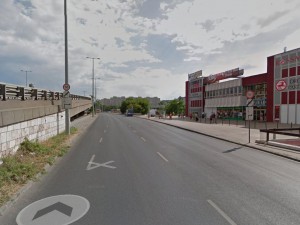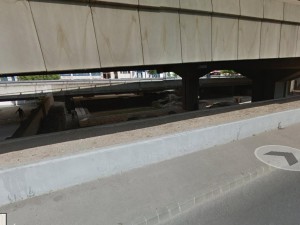Baths or palace?
Anywhere we walk or drive in Óbuda, we can come across Roman remains. We get to see the past and how it fits into the framework of the modern city. For this post we’re getting up close with a perhaps less well known Roman remains at the busy traffic hub of Flórián Square.
So where are we now?
We’re on Szentendrei Road, heading towards Árpád Bridge. About 150 m after Raktár Street the road splits: the left lane takes us on the overpass and the right lane towards Pacsirtamező Street.
But first the history!
In its golden age, the ancient Roman settlement, Aquincum could be divided into three important sections around Óbuda (especially Inner-Óbuda). One of these was the 2nd-3rd century legionary fortress in and around Flórián Square; and so there’s a lot to see here for instance the subject of this blog post. We can visit the Thermae Maiores (the larger baths of the legionary fortress) from the underpass, but we can also see it from the road. Its purpose was to offer the 6000 legionaries stationed in Aquincum a place to bathe, exercise and also socialise. Following the requirements of the time, the baths had a changing room, cold, warm and hot-water rooms, steam baths, latrines and a gymnasium. The warm-water room of the baths was the first to come to light thanks to István Schönvisner in 1778. His was the first ‘proper’ archaeological excavation in Hungary, which also unearthed the first archaeological monument of the country. We know the baths’ name from a building inscription. The joint raid of the Quadi, Roxolani and Sarmatians in AD 260 left significant damage in the baths. It remained in ruins for years, but was eventually renovated. The building inscription containing the name Thermae Maiores comes from the year 268. The next major rebuilding came in the 4th century, when the largest ornate building of the legionary camp lost its original function, becoming a palace. The pools were filled in and the bathing areas became halls of the palace. Ironically, a bathing wing with a few heated rooms was added to the north-western side of what was now a palace.
What can we see today?
Heading towards Pacsirtamező Street on Szentendrei Road, we see to our right Flórián shopping centre and to our left the concrete overpass. Glimpsing underneath the latter, we find a 120 m-long stretch of the ancient building complex. Modern excavations of the baths ended in 1985 and the site opened as a museum to the general public. The overpass was built to ensure that the unparalleled Roman remains underneath could be exhibited.
Soon we’ll continue our search for Roman remains around Flórián Square as there are still plenty of other hidden and conspicuous monuments to discover; but more on those later.
All in all, I encourage everyone to have a look at the Thermae Maiores (the modern-day Baths Museum) on foot (for the best view), or from the warmth of your car on a cold morning – but only when the traffic isn’t moving!
Images from: Google Street View
Dániel Kővágó




